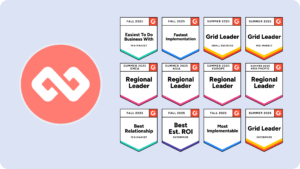While Employee Resource Group (ERG) leaders are usually volunteers, they always care deeply about their cause. However, this may mean they end up in a common bind: they might not know how to turn their passion and concerns into real action.
Thankfully, we’ve helped many ERG leaders create real, lasting change not only in their groups but more broadly across their organizations as well. Here are our top tips.
Be sure to also check out: The Best Practices For Employee Resource Groups: Success Strategies

10 Ways ERG Leaders Can Turn Passion Into Action
1. Create a safe space
While the term “safe space” is sometimes overused, it’s still important to make sure your group understands that empathy and understanding are at the core of how you operate. Otherwise, your people might feel like they won’t be able to actively participate.
How can you go about this? Open conversations will be the key to figuring out what change should look like, so don’t be afraid to dive right in. Give everyone a chance to voice their opinion, and reinforce great ideas with positive feedback.
2. Avoid groupthink
While it’s good to have a space just for a specific interest group, this can sometimes lead to an echo chamber which can cause ERG leaders and members to be slightly out of touch.
Just as it’s important for your organisation to understand your concerns, it’s also important for you to understand what goes on outside of your group and how other people perceive certain issues. Only then can you decide the best way to move forward and the steps you’ll need to take to get there.
3. Align the ERG’s goals with those of the organisation
Aligning the ERG’s work with the organisation’s values, business priorities, and corporate social responsibility goals can help not only reinforce company values, but make achieving them more possible.
That’s because by doing so, it’s more likely an organisation’s leadership team will be invested in the success of ERGs.
4. Focus on innovation
Innovative ideas can lead to actionable change. The Society for Human Resource Management (SHRM) noted that one organisation “started an ERG for men that looked into how they can serve as allies to help women advance at the company. The group eventually expanded its influence to work on behalf of parental leave for men.”
5. Provide mentorship
Oftentimes people in ERGs are minorities or other marginalised communities. Such groups generally tend to miss out on many opportunities, including mentoring, which is why creating a mentoring program can help your ERG make huge strides in the right direction.
Whether you pair up members with those outside of the group to facilitate more access, or pair them with members of the same group to facilitate support, a mentoring program can be how you can leave a legacy and make a real difference in your organisation.
Thankfully, mentoring programs like Mentorloop do all the heavy lifting for you, allowing for ease as they guide you all the way through the process.
And the good news is that this is also an accessible way to make a real, lasting impact. In fact, with Mentorloop Pro, you can create a program for as little as $3,588 a year.
Want to learn how the Mentorloop platform can provide a mentoring program that can boost your company’s ERG success? Speak to Sales – or if you’re eager to get going, get started with Mentorloop Pro.
6. Set clear goals
Create specific, measurable, achievable, relevant, and time-bound (SMART) objectives that guide your efforts and facilitate progress tracking. It is important to have a clear vision of what you want to achieve. Setting SMART goals will help you stay focused and motivated. Make sure your goals are aligned with your organization’s values and mission.
7. Embrace authenticity
Show your vulnerability, share your personal experiences, and encourage open dialogue to foster real connections within your group. Authenticity is key to building trust and creating a safe space for open and honest conversations. As a leader, it is important to lead by example and show vulnerability. Share your personal experiences and encourage others to do the same. This will help create a sense of community and belonging within your group.
8. Identify and challenge biases
Recognize and confront both conscious and unconscious biases within your organization, and work to create a more inclusive environment. Biases can be difficult to recognize, but it is important to be aware of them in order to create a more inclusive environment. Encourage your team to challenge their own biases and to speak up when they witness bias in others. This will help create a culture of inclusivity and respect.
9. Hold events for education and awareness
Host workshops, panel discussions, and training sessions that engage members and expand their understanding of diversity and inclusion issues.
Education and awareness are key to creating real change. Host events that engage your members and help them understand the importance of diversity and inclusion. Invite guest speakers, hold workshops, and facilitate panel discussions. This will help create a more informed and engaged team.
10. Create subcommittees
There are many types of employee resource groups with different needs. Develop specialized teams to address particular areas of concern and maximize the impact of your efforts.
Creating subcommittees can help maximize the impact of your efforts by focusing on specific areas of concern. Assign team members to focus on recruiting, community engagement, or event planning. This will help ensure that all aspects of your ERG are covered and that your efforts are aligned with your goals.
Remember, turning passion into action requires commitment and perseverance. Keep your goals in mind and stay focused on your vision. With dedication and hard work, you can make a real difference in your organization!
Developing a Strategy for Positive Change
Creating lasting change within an organization requires a well-defined strategy. The following steps can help ERG leaders outline a roadmap for success:
- Analyze your organization’s culture and structure: Before implementing any changes, it is important to understand the current state of your organization. Analyze the culture and structure to identify areas that need improvement. This analysis can be done through surveys, focus groups, and interviews with employees. For example, if your organization has a culture of exclusivity, it may be difficult for underrepresented groups to feel included. By identifying this issue, you can develop strategies to promote a more inclusive culture.
- Establish a vision: Define the goals you want to achieve as an ERG and the impact you wish to have on your organization. This vision should align with the overall mission and values of your organization. For instance, if your ERG is focused on promoting gender diversity, your vision could be to increase the representation of women in leadership positions by 50% within the next two years. This vision will guide your ERG’s actions and help you stay on track.
- Develop an action plan: Outline the steps your ERG will take to accomplish its goals, and define clear responsibilities for each member. This plan should include specific actions, timelines, and metrics for success. For example, if your ERG’s goal is to promote diversity in hiring, your action plan could include creating partnerships with universities that have diverse student populations, developing a mentorship program for underrepresented groups, and hosting job fairs that target diverse candidates.
- Engage stakeholders: Collaborate with organizational leaders and other ERGs to build partnerships and synergies that accelerate your progress. By working with other groups, you can leverage their expertise and resources to achieve your goals more efficiently. For instance, if your ERG is focused on promoting disability inclusion, you could partner with the IT department to ensure that all technology used in the workplace is accessible to individuals with disabilities. This partnership will help you achieve your goal more effectively and efficiently.
- Monitor and adjust: Regularly assess your performance against your objectives, and adapt your strategies as needed to remain effective. This monitoring should include both quantitative and qualitative data to ensure that you are making progress toward your goals. For example, if your ERG’s goal is to increase the retention of underrepresented groups, you could track the retention rates of these groups and conduct exit interviews to understand why employees are leaving. Based on this data, you can adjust your strategies to address any issues and improve retention rates.
By following these steps, ERG leaders can develop a well-defined strategy for positive change within their organization. This strategy will help them achieve their goals and create a more inclusive and diverse workplace.
Empowering ERG Leaders to Make a Difference
For an Employee Resource Group (ERG) to be truly transformative, its leaders must be empowered and enabled to drive change. Here are some ways to build leadership capacity within your organization:
- Invest in training: Develop a comprehensive training program that teaches leaders how to create an inclusive workplace culture, how to communicate effectively with team members, and how to implement diversity and inclusion practices. Provide workshops, conferences, and courses to develop strong leaders with a deep understanding of diversity and inclusion practices. By investing in training, you are investing in your leaders and in the success of your ERG.
- Create a mentoring program: Connect experienced leaders with new or aspiring leaders, fostering a culture of continuous learning and growth. Mentoring programs allow leaders to share their knowledge and experience, while also providing support and guidance to those who are just starting out. By creating a mentoring program, you are building a community of leaders who are invested in each other’s success.
- Recognize and reward efforts: Show appreciation for your team, celebrating their accomplishments and acknowledging their dedication to real change. Recognition can take many forms, such as public recognition at meetings or events, awards, or bonuses. By recognizing and rewarding your team, you are showing them that their efforts are valued and appreciated.
- Build a support network: Encourage collaboration and the sharing of resources, both within your ERG and with other groups in your organization. Building a support network can help leaders to feel less isolated and more connected to the larger organization. It can also help to break down silos and promote cross-functional collaboration. By building a support network, you are creating a community of leaders who can learn from each other and work together to drive change.
Empowering ERG leaders is essential to creating a culture of diversity and inclusion within your organization. By investing in your leaders, you are investing in the success of your ERG and in the success of your organization as a whole.
Utilizing the Power of Collaboration
True change cannot be achieved in isolation. Collaboration is essential for amplifying the impact of your ERG’s efforts. Here are some strategies for fostering productive partnerships:
- Form alliances with other ERGs: Connect with groups that share similar objectives, and explore opportunities for joint initiatives and resource-sharing.
- Engage the broader organization: Involve employees from various departments to create cross-functional teams, fostering wider support and understanding.
- Partner with external organizations: Network with community groups, industry associations, and other businesses to share best practices and leverage their expertise.
- Align with organizational goals: Ensure that your ERG’s objectives align with those of your organization to pave the way for collaboration and support.
Leveraging Resources for Maximum Impact
With limited resources, how can ERG leaders ensure the highest return on investment? Consider these ways to optimize your resource allocation:
- Assess and prioritize: Evaluate the potential impact and feasibility of different initiatives to determine which ones are worth pursuing.
- Streamline operations: Optimize your ERG’s processes and procedures to minimize waste and inefficiency.
- Focus on high-impact interventions: Concentrate your resources on initiatives that directly address the root causes of inequality and exclusion.
- Measure and analyze performance data: Track your progress and analyze your results to inform future decisions and resource allocation.
How to Measure the Success of Your Group
To assess the effectiveness of your ERG’s efforts and continuously improve, it’s crucial to measure success. Here are some considerations for evaluating your group’s performance:
- Define success criteria: Establish clear, quantifiable indicators of success that align with your ERG’s objectives.
- Collect and analyze data: Gather data on your group’s activities and outcomes, and use this information to identify trends and patterns.
- Conduct surveys: Solicit feedback from employees to gauge their perceptions and experiences of your ERG’s interventions.
- Compare with benchmarks: Evaluate your own results against industry standards and best practices to identify areas for improvement.
- Prioritize continuous improvement: Use your findings and insights to drive ongoing refinement of your strategies and initiatives.
In conclusion, as an ERG leader, you have the power to create lasting change within your organization. By employing the strategies and practices outlined in this article, you can turn your passion for diversity and inclusion into tangible results that benefit your colleagues, your organization, and society as a whole.




